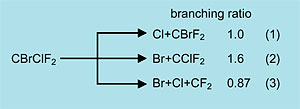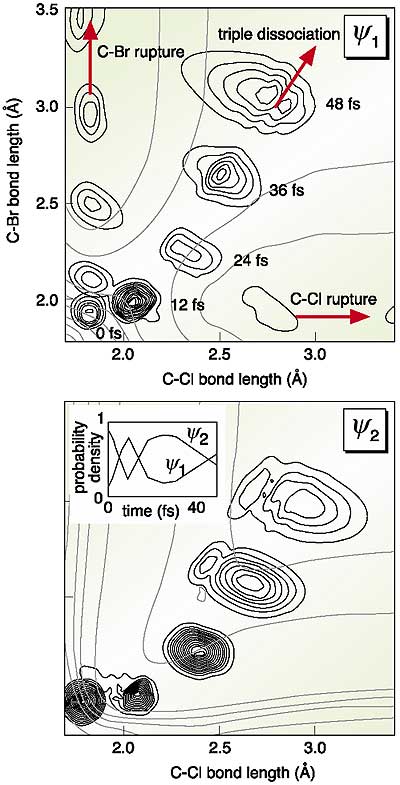Lasers can be employed to produce controlled chemical reactions. Since the chemical bonding in a molecule is determined by the electrons of the constituent atoms, we can expect a particular chemical bond to rupture if we change the dynamical state of the relevant electrons or if we add another electron to the chemical bond. We have studied the photo-decomposition reaction of CFClBrX(X=F, CBrF2, etc.), in which four different atoms or groups of atoms are bonded to a carbon atom. By using laser radiation of wavelength 157.6 nm, an electron mainly belonging to the Cl atom is excited to the C-Cl sigma anti-bonding molecular orbital designated as the sigma*(C-Cl) n(Cl) transition. The excitation will weaken the bond, resulting in Cl-atom dissociation. In fact, our experiments have shown that, besides Cl-atom formation, Br-atoms are also formed in various ratios depending on the nature of the complex X. Figure 6-3 summarizes the results obtained with CBrClF2. For this case we have performed a theoretical analysis (Fig. 6-4). The dissociation dynamics of the laser-generated repulsive sigma*C-X (X = Cl, Br) states of CBrClF2 have been studied in terms of propagating wave packets Psi1 and Psi2 on two potential energy surfaces calculated using the complete active state self-consistent field (CASSCF) method. The results have confirmed the occurrence of a simultaneous triple dissociation process in which both Cl and Br are produced. Furthermore, we found that the reaction involves a process of jumping between the two surfaces and the coupling strength of the potential interaction is the main factor controlling the branching ratio of the reaction. These findings are highly relevant information for the control of laser-induced chemical reactions. n(Cl) transition. The excitation will weaken the bond, resulting in Cl-atom dissociation. In fact, our experiments have shown that, besides Cl-atom formation, Br-atoms are also formed in various ratios depending on the nature of the complex X. Figure 6-3 summarizes the results obtained with CBrClF2. For this case we have performed a theoretical analysis (Fig. 6-4). The dissociation dynamics of the laser-generated repulsive sigma*C-X (X = Cl, Br) states of CBrClF2 have been studied in terms of propagating wave packets Psi1 and Psi2 on two potential energy surfaces calculated using the complete active state self-consistent field (CASSCF) method. The results have confirmed the occurrence of a simultaneous triple dissociation process in which both Cl and Br are produced. Furthermore, we found that the reaction involves a process of jumping between the two surfaces and the coupling strength of the potential interaction is the main factor controlling the branching ratio of the reaction. These findings are highly relevant information for the control of laser-induced chemical reactions. |


